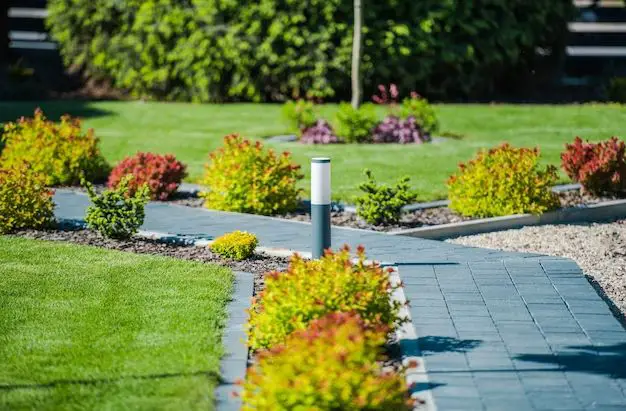Landscaping your front yard can seem like an expensive project, but with some planning and DIY solutions, you can transform your exterior space without breaking the bank. Here are some tips for landscaping your front yard on a budget:
Page Contents
Assess Your Needs
Before starting any landscaping project, it’s important to assess what you want to accomplish. Consider the following:
- What is your budget?
- What areas need the most improvement?
- Do you want mostly hardscaping (patios, walkways) or softscaping (plants, trees)?
- What functionality do you want (play space, entertaining, curb appeal)?
- What is the style you are going for (formal, cottage, contemporary)?
Having a plan based on your needs and budget will help guide cost-effective decisions.
Improve Existing Elements
The most budget-friendly way to overhaul your landscape is to work with what you already have. Look for ways to refresh or enhance existing elements before taking on brand new features:
- Can you give your lawn an overhaul with overseeding and fertilizer vs. complete resodding?
- What plants or trees can be pruned or trimmed instead of removed?
- Can you edge or pressure wash walkways and patios instead of replacing them?
- Is a fresh coat of mulch or rock enough to spruce up garden beds?
Revitalizing tired elements first can make a big visual impact with little cost.
Add Focal Points
Carefully choosing statement pieces or focal points is an affordable way to upgrade your landscape. splurge on a few eye-catching additions that will draw the eye:
- An ornate garden gate at the entrance
- A stone accent wall or fire pit for the patio
- A water feature like a fountain or pond
- Hanging flower baskets or decorative containers
- Artwork like garden statues, sculptures, or signs
Focus your bigger investments on these special details to maximize visual impact. Support them with inexpensive DIY touches like mulch and lighting.
Do It Yourself
From planting beds to hardscaping, there are many landscaping tasks you can DIY to control costs. Here are some top projects for homeowners to tackle:
| Project | Estimated Savings |
|---|---|
| Mulching | 80% |
| Planting trees, shrubs, and perennials | 50% |
| Laying sod | 45% |
| Edging and weeding beds | 90% |
| Installing pathway lighting | 55% |
| Building a garden fence | 40% |
Doing the labor yourself on projects like these can cut costs dramatically. Focus on tasks within your skill level and allow for extra time to learn as you go.
Buy In Bulk
When purchasing materials like mulch, soil, gravel, and plants, buying in bulk quantities can lead to major savings. Split bulk purchases with neighbors or friends to save even more. Shop sales and clearance events at home improvement stores or nurseries for discounted materials.
Use Coupons and Rebates
Garden centers, nurseries, and home stores often offer coupons and rebates, especially during peak gardening season. Check flyers, sign up for loyalty programs, and look for coupons to lower the cost of plants, lawn care products, and tools. Using credit cards with rewards on gardening purchases can also add up to extra savings.
Shop Secondhand
It’s easy to find used and budget-friendly materials:
- Check Craigslist and Facebook Marketplace for cheap or free items, like used brick, stone, fencing, tools, and garden decor.
- Visit salvage yards and reuse stores for discounted landscaping materials in good shape.
- Ask neighbors and friends if they have extra plants, dirt, gravel, etc that they’d be willing to pass along.
Repurposing materials in good condition prevents usable items from ending up in landfills.
Wait for Off-Season Pricing
The peak seasons for landscaping projects are spring and fall. You can often save up to 50% or more by shopping in the off-season months of summer and winter. Nurseries and garden centers try to clear out inventory with massive discounts during slower months.
Big sales also happen in fall on summer items like water gardens, tropical plants, and patio furniture. Shop winter months for deals on hardscaping materials, trees, shrubs, mulch, and soil to prep for spring planting. Just be sure to store items properly until you’re ready to use them.
Start Small
When working with a limited budget, it’s best to take on small sections of your landscape gradually. Simple upgrades like refreshing your garden beds or adding a walkway can make a big visual difference and are more budget-friendly than renovating your entire yard all at once. Focus on a few small areas first, then build upon your design over time as your budget allows.
Consider Alternatives
Sometimes the materials you have in mind for landscaping, like natural stone and pavers, are out of your budget. Consider more affordable alternatives that can mimic the look for less:
- Use poured concrete with molds instead of expensive paver stones.
- Choose wood planks rather than stacked stone for garden walls.
- Use pea gravel as a walkway filler versus rocks or mulch.
- Select wood benches and composite decking over pricier cedar and redwood.
Getting creative with material substitutes can give you big savings without sacrificing style.
Do Your Research
Always research costs thoroughly before starting new landscaping features. Get multiple quotes and look for ways to lower expenses through different material or design choices. Use online calculators to estimate the cost of materials needed for patios, retaining walls, plantings, and more based on your yard’s square footage. Being informed on potential costs will help you create an accurate budget.
Conclusion
With strategic planning and cost-saving tips, you can tackle landscaping projects on a tight budget. Focus on improving existing elements first, splurging selectively on statement pieces, buying in bulk, using coupons and sales, sourcing secondhand items, shopping off-season, starting small, and researching thoroughly. The end result will be a beautifully transformed outdoor space that adds value and curb appeal to your home without breaking the bank.
